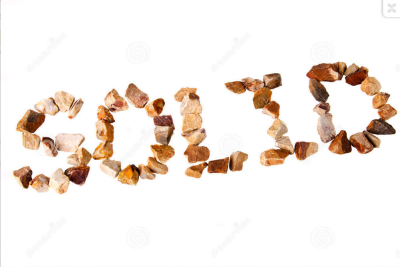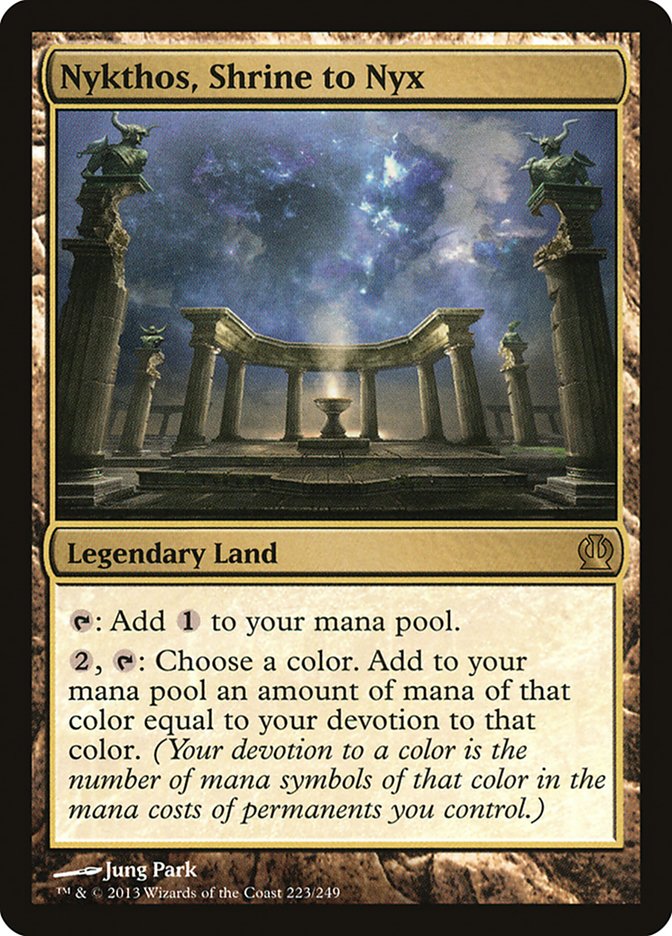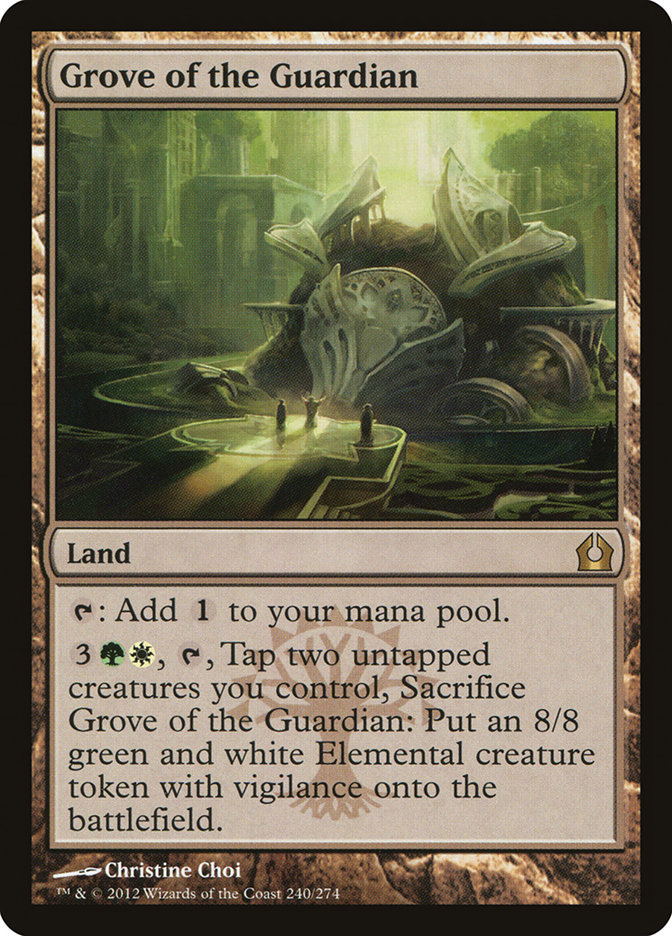Folks, this is a sturdy metagame.

There’s a handful of planets in our solar system, and most every idea orbits around one of them. Between them monocolored devotion decks, U/W/x Control, and monocolored aggro decks fill everything for the top slots, leaving room for little in the realm of the niche.
Now don’t worry; I’m not here to gripe about the best decks in the format. I played one of them last week (though this moment in the metagame challenges that claim to a degree), and I had a really enjoyable experience. These decks are tailored and neat, and among other things they reward good play and sideboarding. For most Magic players, this is plenty to get excited about. For a tournament player that’s interested in showcasing their talents, these decks offer excellent opportunities to do so. It’s also important to remember that the fall season of Magic is the longest one that goes without an update, so pros and amateurs alike have four solid months to brew the best the format can yield.
The proliferation of monocolored decks and their continued strength and success owe themselves ironically to something that has no color at all:
The powerful interaction between Nykthos and the hybrid-mana creatures of the Ravnican ecumenopolis have created powerful turns where green players churn out lots of mana, red players deal lots of damage, black players drain lots of life, blue players bounce your permanents or sneak past your line, and white players . . . well, haven’t quite tackled that one yet, though many of us have tried. This Cabal Coffers like land has given players the ability to draw and cast their best creatures and has singlehandedly resurrected the use of dice to track your opponent’s mana pool contents. Mutavault is also another essential player; if you don’t play Nykthos, you’re likely on the Mutavault plan if color weight isn’t a problem for you. Together these two lands feature in almost every major deck that we’ve seen over the past two months.
My deck today aims to divorce itself from the grips of each of these lands. In fact, neither land is conducive to the strategy presented today. Instead, I’ll represent the deck I’m planning today with a third completely untouched nonbasic land we’ve had since September 2012:
This Selesnyan offering appeared as a singleton in some Block Constructed decks and perhaps even in a decent G/W/x deck from the early days of Return to Ravnica Standard, but it was gone in a flash.
Although the land is not central to our strategy, it is representative of the token plan that I wish to revive. The landscape for token decks has changed since we last visited it; Lingering Souls; Intangible Virtue; and Talrand, Sky Summoner were the token champs of choice back then, but now tokens are incidental players in certain archetypes (e.g. Xathrid Necromancer, Master of Waves) and are not synergistically tied to one another despite the presence of token-loving mechanic populate.
On the drive home for Indianapolis last week, I had a couple hours to consider the decks I’d play if I could do Saturday over. I considered every deck I played against that day, which ones looked fun and which ones were outdated. I played a G/W Aggro deck in round 4, which gave me first loss of the day, and I started there. I loved the flash aspect of the deck that keeps you in charge while your opponent resolves all their boring sorcery-speed stuff. The ability to recover quickly, the synergetic spells, and the underutilization of the still-awesome Voice of Resurgence led me to build a G/W shell in my head. Young Pyromancer came up shortly afterward; I was casting a lot of instants in this imaginary battlefield, and it produced tokens too. What cares about tokens, or more accurately having a lot of them?
I gasped in my unlit car; I had it.
Creatures (10)
Lands (24)
Spells (26)

Creatures
Saying there are ten creatures in this deck is only true in the strictest sense; by themselves fifteen other spells maindeck make at least one creature. First off, Voice of Resurgence is a really good Magic card. It’s a bummer and a half to kill, and it’s difficult for your opponent to do so without losing a little bit of value. You can get it in early enough to dodge a Thoughtseize (if they play a scry land first let’s say), and then it’s one of the biggest threats any G/W Aggro deck will produce. Any deck that plays one may not know it, but they actually want to play four. Huge fan.
Anyway, it’s not only an excellent card, but it generates creatures whenever your opponent counters the spells you cast on your turn, they try to kill something on your turn, or they smash the Voice outright. Getting free creatures is good in Magic, and keeping the creature count high is important for this deck too.
Young Pyromancer, like Voice, has received a ton of attention, but I’m not sure they’ve gotten it at the same time. Every token producer gives you two for the price of one, although one is small and often helpful only as a chump blocker even it plays a role in the deck’s plan. Trostani, Selesnya’s Voice is still in my opinion one of the neater cards given our current situation.
While spot removal can still target her, she is an exceptional force in combat, blocking 4/4s, making copies of your best creature each turn, and gaining you a significant amount of life each turn. It’s nearly impossible to burn with one card, and the life gain can help keep you out of range of a dangerous Fanatic of Mogis or Gray Merchant of Asphodel. With Doom Blade and Hero’s Downfall skating around, she’s a bit weaker, but I still like a couple of her to help you scrape back from a low creature count.
Token Makers
Call of the Conclave is probably the weakest card in the deck, but it still provides a 3/3 that interacts with the token effects and Young Pyromancer triggers that this deck promotes. Most decks want (and should use) Fleecemane Lion instead, but a list like this is perhaps the only exception. For two mana more Advent of the Wurm is a much more powerful and exciting card, nearly always catching an attacking force off guard. Being a 5/5 is a huge boon in this format, letting you brawl with nearly anything but Gods.
Selesnya Charm, while technically a token, is so much more than that. Selesnya Charm is an exceptional removal spell first and foremost, undoing turns of planning for just two mana. Exile a Polukranos, World Eater in response to a monstrous activation; banish any of the five Gods; or devour an Obzedat, Ghost Council! It also has the potential to produce a token as needed, and its Wildsize ability is not irrelevant; I’ve won a handful of games off the back of a timely pump, and I’m sure you have too. Give that Risen Sanctuary token some big stompy boots!
I want to take a second for Alive // Well. This is a card I haven’t seen a single copy of outside a draft table. Most times it’s an excellent draft choice, giving you a slightly overcosted 3/3 and a bunch of life. If the deck’s whole goal is to make tokens and creatures, isn’t Alive // Well potentially devastating to an aggro deck? I believe it is; in many instances this is a very underpowered Thragtusk (creature + life for five mana), but it has the potential to provide you life in the double digits. As those powerhouse decks beat down, you’ll be prepared to take a few smacks. Hammer of Purphoros not only lets you mobilize a token army from your hand that’s ready to swing, but it can make more creatures from your lands, increasing your counts and providing populate targets.
Win Conditions
I didn’t mention the actual way this deck wins. It seems self-explanatory—make a bunch of creatures and smash. Normally this would be the case, but we don’t live in old Magic anymore where calculated blow for blows decided matches. Now we’ve got to get a little fancier. Massive Raid became my original game plan for victory. For three mana you can either demolish a powerful creature or in a more optimal scenario lance your opponent at a discount, dealing five, six, or ten damage on the cheap. The flexibility of the spell warranted the original inclusion of four; it’s able to destroy a creature early on, and then you can use your next one to alpha strike your opponent.
Righteous Charge is a card that’s seen very little play, and I understand why; with Spear of Heliod providing half the bonus forever, Righteous Charge looks a lot less like a deal. However, the extra point of power spread across a handful of creatures can mean the difference from bringing your opponent to five and your opponent to zero. This turns a humble army of a Voice of Resurgence, a Pyromancer, and two Elementals into fourteen damage and another Elemental if it ends up mattering. It’s also nice and cheap, meaning that you can alpha strike and keep up a defensive spell in case things go poorly.
Boros Charm doesn’t fit anywhere else, but it’s an essential piece to this deck. This token deck, unlike some more aggressive variations we’ve seen in the past, is a bit more about planning. You’ll need to be thinking if you need an extra creature to make Massive Raid lethal or if you have to make sure your team survives this potentially deadly attack. Boros Charm is there to save you in those instances. It still does a great job of demolishing many planeswalkers in one shot, and it still deals four damage to the face when you need it. A pair of Massive Raids followed by a Boros Charm can be game winning all on their own.
Lands
As I built this deck in my head and then on paper, I was struck with a significant problem that this deck faces that most every other archetype has in abundance: card advantage. As much as I tried, I couldn’t find good draw potential in the Nayan library of Standard cards. Most are conditionally bad for decks of this type and/or the advantage they provide is irrelevant or mitigated by the deck’s style.
My only solution to the card advantage problem was through card selection. Eight scry lands (and potentially twelve in a few weeks) need to be here to help keep you from drawing that fourteenth land or creature-reliant spell on an empty board. From there I jammed as many shock lands as I can sport and a Grove of the Guardian to top things off; I don’t expect to use it too often, but the potential detriment from striking a colorless land seemed minimal enough.
Sideboard
From the sideboard the deck has the potential to shift into a long-game control-beating machine. Sundering Growth is a pleasant four-of; normally Naturalizes don’t occupy this much space in the sideboard, but the built-in populate and the prevalence of targets (even if you can’t destroy them, like Gods for example) makes this card a natural inclusion for the list. The ability to easily cast it doesn’t hurt. Rootborn Defenses acts as Boros Charms #5-#7 for the purposes of protecting your team. If it turns out you just need an extra token, you can use it for that too, but with the danger of Supreme Verdict looming, this card is a necessary tool in today’s Standard.
Assemble the Legion is a great win condition. Many decks can’t deal with it on an empty board, and adding Massive Raid helpers will whittle down your opponent lickety-split. The last five cards, two planeswalkers, answer distinct needs that this deck possesses. Xenagos is a great engine against control, as stated in my previous analyses, and Chandra will draw you token makers or extra Voice of Resurgences. Xenagos’ first ability has the potential to produce a ton of mana too if you need to fill the board with creatures and preserve your lands for instants in your hand.
In practice this deck had some serious hosers (Golgari Charm to sweep away Pyromancer tokens and the Wizard too), but I was able to quickly recover from large-scale sweeper effects. Mono-Black Devotion was probably the most difficult deck to interact with since Thoughtseize was brutal and I didn’t have much interaction against Gray Merchant of Asphodel or Pack Rat, though Erebos, God of the Dead and Desecration Demon were a piece of cake. Versions of Mono-Blue Devotion that played Cyclonic Rift were also particularly deadly.
This list is a lot of fun, but it needs some refinement to work in the real world.
After setting this one down, I drafted up a quick Junk Tokens list that follows a more traditional path; it also adds draw power without giving up protection (Golgari Charm is a great utility card right now), and the power level itself may be a bit higher. Take a look for yourself and let me know what you think!
Creatures (13)
Planeswalkers (3)
Lands (24)
Spells (20)

Maybe the time for tokens hasn’t passed yet. Today’s Standard requires intervention, so a billion creatures have to kill you pronto in order to answer the format’s strongest decks. I think it’s worth exploring, but exercises like this are still important even if they don’t yield a back-breaking format-answering archetype.
These lists are suitable for Friday Night Magic, but maybe not a large tournament. Try them out and let me know how it goes, or maybe you’ve been working on something yourself that incorporates these decks’ elements!
With Born of the Gods spoilers rushing out of the mothership’s tap, we’ll have plenty to talk about in the coming weeks. I still have several brews that don’t involve the middle set of Theros, but I’ll be ready the moment it’s released to share exciting new builds and strategies with you.


